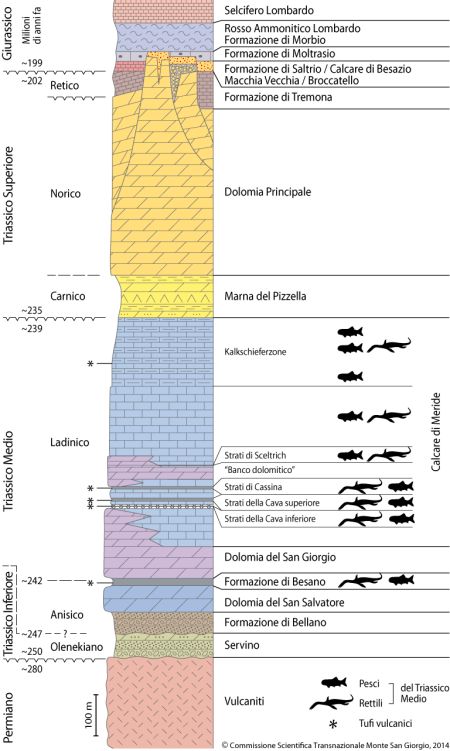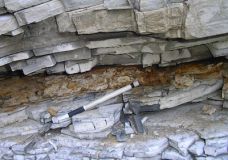The fossiliferous levels
The most important fossil beds occur in the central part of the stratigraphic series, within the carbonate sedimentary rocks of marine origin (limestone and dolomite) that were formed during the Triassic. So far, six particularly rich fossiliferous levels have been identified within a more then 600 metres thick succession of rocks dating from the Middle Triassic and covering a period of four million years (from 243 to 239 million years ago).
The oldest level is the so-called “Grenzbitumenzone”, now known as the Besano Formation. This sedimentary rock formation of up to 16 m thickness is characterized by alternating layers of dolomite, bituminous shale and volcanic ashes (tuffites). In stratigraphic and geochronological studies, it is the best known of the levels and has provided the most spectacular discoveries of fish and reptiles along with important index fossils, such as ammonoids and bivalves (daonelles).
Above, but separated by a 60 m thick series of massive dolomites called the San Giorgio Dolomite, is the Meride Limestone that contains five successive fossiliferous beds. The first three (the Cava inferiore, Cava superiore and Cassina beds) belong to the lower Meride Limestone and are characterized by thin layers of laminated limestones intercalated with volcanic ashes. In contrast, the Kalkschieferzone at the top of the Meride Limestone is characterized by the alternation of limestones and marls. These layers have provided many vertebrate and invertebrate fossils, including the first Triassic insects from Monte San Giorgio. A new level that is also particularly fossil-rich (the Sceltrich beds) has recently been identified in the upper Meride Limestone and is currently being studied.
From these six levels over 20,000 fossils have so far been extracted thanks to scientific excavations by the Palaeontological Institute and Museum of the University of Zurich, the Museo cantonale di storia naturale of Lugano, the Museo Civico di Storia Naturale of Milan and the Dipartimento di Scienze della Terra der Università degli Studi of Milan. To date, approximately 25 species of reptile, 50 species of fish and more than 100 species of invertebrates have been recorded in addition to various species of plants, particularly conifers. The scientific names attributed to some of the newly described organisms recognise the places where they were found, for example, Ticinosuchus, Ceresiosaurus, Serpianosaurus, Besanosaurus or Meridensia.
Stratigraphic column of Monte San Giorgio with fossiliferous levels, © Commissione Scientifica Transnazionale MSG 2014






